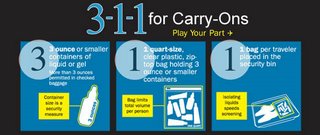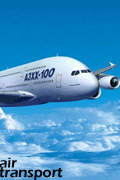|
posted by transport blogs
@ 2:15 AM
permanent link |
|

posted by transport blogs
@ 3:33 AM
permanent link |
|

posted by transport blogs
@ 11:29 PM
permanent link |
|

Tuesday, April 21, 2009 - U.S. scheduled passenger airlines employed 6.6 percent fewer workers in February 2009 than in February 2008, the eighth consecutive decrease in full-time equivalent employee (FTE) levels for the scheduled passenger carriers from the same month of the previous year, the U.S. Department of Transportation's Bureau of Transportation Statistics (BTS) reported today . The February FTE total of 391,682 for the scheduled passenger carriers was an increase of 1,025 from January but still was second lowest total since 1993. FTE calculations count two part-time employees as one full-time employee.
All the network airlines decreased employment from February 2008 to February 2009 as did low-cost carriers AirTran Airways, Frontier Airlines and Spirit Airlines. Regional carriers American Eagle Airlines, SkyWestAirlines, ExpressJet Airlines, Comair, Atlantic Southeast Airlines, Horizon Air, Mesa Airlines, Executive Airlines, and PSA Airlines also reported reduced employment levels compared to last year.
Scheduled passenger airline categories include network, low-cost, regional and other airlines.
The seven network carriers employed 264,561 FTEs in February, 67.5 percent of the passenger airline total, while low-cost carriers employed 16.1 percent and regional carriers employed 14.7 percent.
American Airlines employed the most FTEs in February among the network carriers, Southwest Airlines employed the most FTEs among low-cost carriers, and American Eagle employed the most FTEs among regional carriers. Seven of the top 10 employers in the industry are network carriers.
America West Airlines and US Airways now operate under a single certificate. Joint reporting began with October 2007 data. Before October 2007, US Airways employment numbers were included with the network airlines, while America West's numbers were included with the low-cost airlines. Beginning with October 2007 data, US Airways numbers are combined with America West's numbers in the network airlines category.
              
posted by transport blogs
@ 10:14 PM
permanent link |
|

posted by transport blogs
@ 2:49 AM
permanent link |
|

Thursday, April 16, 2009 - U.S. airlines carried 51.5 million scheduled domestic and international passengers in January 2009, 10.9 percent less than they did in January 2008, the U.S. Department of Transportation's Bureau of Transportation Statistics (BTS) today reported in a release of preliminary data.
BTS, a part of DOT's Research and Innovative Technology Administration, reported that the decline was the 11th consecutive monthly decrease in system passengers from the same month of the previous year.
U.S. airlines carried 11.5 percent fewer domestic passengers and 7.2 percent fewer international passengers in January 2009 than in January 2008. These passengers traveled on planes with average load factors of 73.0 percent.
Top Airlines in January
Southwest Airlines carried more total system and domestic passengers in January 2009 than any other airline and American Airlines carried more international passengers.
Top Airports in January
More total system and domestic passengers boarded planes in January 2009 at Atlanta Hartsfield-Jackson International than at any other U.S. airport more international passengers boarded U.S. carriers at Miami International than at any other U.S. airport
Flights Operated
U.S. carriers operated 769,500 domestic and international flights in January 2009, 11.2 percent fewer than in January 2008. Domestic flights were down 11.6 percent from January of the previous year while international flights fell 7.5 percent
System Comparisons
In other total system comparisons from January 2008 to January 2009 :
Revenue passenger miles (RPMs), a measure of the number of passengers and the distance flown, were down 9.9 percent in January 2009.
Available seat-miles (ASMs), a measure of airline capacity using the number of seats and the distance flown, were down 8.8 percent in January 2009.
Passenger load factor, passenger miles as a proportion of available seat-miles, was down 0.9 load factor points at 73.0 percent in January 2009.
Flight stage length, the average non-stop distance flown per departure, was up 0.4 percent in January 2009.
Passenger trip length, the average distance flown per passenger, was up 1.1 percent in January 2009.
Among U.S. airlines, Southwest Airlines carried 7.0 million passengers on its system in January 2009, the most of any airline.
Among airports, Atlanta Hartsfield-Jackson International was the busiest U.S. airport in January 2009, with 3.1 million domestic and international passenger boardings on U. S. carriers. Labels: January 2009 Airline Traffic
              
posted by transport blogs
@ 10:50 PM
permanent link |
|

WASHINGTON, DC - U.S. Secretary of Transportation Ray LaHood today announced that airports around the country will receive $46.0 million under the recently enacted American Recovery and Reinvestment Act of 2009 (ARRA).
 "The American Recovery and Reinvestment Act is creating jobs across the cou  ntry today while laying the foundation for the safety and economic vitality of our airports in the years to come," said Secretary LaHood. The Federal Aviation Administration will provide funding for airports in Alabama, Alaska, California, Indiana, Michigan, Ohio, Pennsylvania and Wisconsin. This is in addition to the $258 million in ARRA funds for U.S. airports announced by Secretary LaHood on April 8. About 3,400 airports designated as part of the national airport system are eligible to receive ARRA funds. The FAA is moving swiftly to work with airport sponsors to ensure eligible projects have completed or nearly completed, design and planning requirements. Under ARRA, the FAA received $1.1 billion to allocate to qualified airports on a discretionary basis. That funding will be distributed based on a project priority system that addresses airport safety and security, infrastructure, runway safety, increased capacity, and mitigation of environmental impacts. Secretary LaHood said the Obama Administration is committed to getting ARRA money into the economy as quickly as possible. He noted that President Obama signed the ARRA into law on February 17, less than one month after taking the oath of office. Less than two weeks later, on March 3, LaHood joined President Obama and Vice President Biden at an historic announcement at the U.S. Department of Transportation to mark the release of $26.6 billion to the states and localities for highways, roads and bridges. The release of funds came eight days earlier than required by law. On March 5, Secretary LaHood joined Vice President Biden and Miami Mayor Manny Diaz to announce the availability of $8.4 billion for transit infrastructure. On March 12, Secretary LaHood announced that Pittsburgh International and Allegheny County Airports had received the first funding allocations for airport infrastructure projects, and on March 13, Vice President Biden announced that DOT made $1.3 billion available to Amtrak for capital and security improvements. On April 13, just six weeks after the announcement of funding for the first transportation project under ARRA, President Obama announced funding for the 2,000th transportation project. Labels: Economic Recovery Funds for Airports
              
posted by transport blogs
@ 10:12 PM
permanent link |
|

 Two air traffic controllers are rapidly earning heaps of praise for helping a distressed passenger guide a plane to safety Sunday after the pilot died in the cockpit. Brian Norton and Dan Favio, who both work the TRACON at Southwest Florida International Airport in Ft. Myers, helped a passenger sitting in the co-pilot's seat as he guided the twin-engine plane to safety after the pilot's apparent heart attack. "I couldn't be more proud of them, said Steve Bushey, the tower's manager. "We're happy to have a good story and particularly because the outcome was positive. You can't beat that."
One of the passengers, Doug White, who previously had only flown single-engine planes, was forced under the circumstances to fly his family to the airport after he declared an emergency. White already had enough on his mind. He was returning to Louisiana - with a stop in Mississippi to retrieve his truck - after attending a funeral for his only brother. His wife and two teenage daughters were in the back of the plane and now he was charged with getting them on the ground.
A few minutes into the flight of N559DW, when the King Air 200 was 10,000 feet aloft and climbing, White radioed the Miami Center that there was an emergency. Controllers at the Ft. Myers airport were quickly notified, and a radar scope showing only the King Air was set up in the tower.Controller Brian Norton was walking down the hallway and ready to leave for the day when his supervisor called him back because of his piloting experience.
He plugged into the console and "could tell the pilot was struggling a little bit to get the plane under control. He told me he was getting alarms in the cockpit and he was descending too fast," Norton said. "It's a pretty complex airplane."
Dan Favio, a developmental controller who has been with FAA for six months after military and private contracting controller experience, learned of the problem while he was eating lunch. Thinking quickly, he called a friend and flight instructor, Kari Sorenson, who had thousands of hours of flight experience on the King Air 200.
"I sat beside Brian and called [Sorenson]," Favio said. He just happened to be sitting in his office and he was able to pull out the checklist for the [King Air 200] and the cockpit diagram." As the pilot asked questions - air speed, flap control, trim locations - Favio relayed the questions back to his friend. Favio, who also has logged some time behind single-engine planes, said his biggest concern was that White would slow the plane too much. Because landing speeds for twin-engine airplanes are much faster than those for single-engine planes, Favio continued to tell Norton, who then told White, what the minimum airspeed was and not to drop below it.
"He definitely had his hands full. He was concerned about being able to handle that airplane,"Norton said. That the pilot had his hands full isn't surprising. Sorenson said the King Air 200 is "one of the most complicated airplanes to fly." At first, White reported having difficulty trying to control the King Air 200. Sorenson told him - through the controllers - to fly it like it was a single-engine plane. "Once he started doing that that's when things really started to settle down," Sorenson said. About six miles from Runway 6, with the winds nearly calm, White asked for final approach speed. Favio asked his friend and the answer was quickly relayed to White.
Through that relay, Norton helped White line up his approach, adjust his flaps to the proper setting and put the landing gears down at the proper airspeed and altitude. Meanwhile, Favio was calling out altitudes and airspeeds to Sorenson. Everything looked good, but Favio was worried the pilot was coming in a little bit short of the 12,000-foot runway at the Ft. Myers airport. After a brief pause in the communication, an audibly shaken White can be heard coming over the microphone."We're down, buddy. Thank you," he said.
Labels: Controllers to the Rescue, Pilot Stricken
              
posted by transport blogs
@ 10:15 PM
permanent link |
|

With the stroke of a pen, the FAA on April 7 agreed to work in cooperation with China to share best environmental practices at airports in the two countries. The agreement was reached at the U.S.-China Aviation Symposium in Beijing.
The FAA's acting assistant administrator for international aviation, Di Reimold, joined representatives from the U.S. Trade and Development Agency and the Civil Aviation Administration of China in signing the Memorandum of Understanding that outlines the agreement.
The agreement is designed to enhance U.S. and Chinese aviation. It's a relationship that "continues to mature. It's just continuing to grow," said Gene Kingsbury, who manages the FAA's Asia-Pacific Division.
While the environment is an important part of the symposium, officials also concentrated on air traffic and safety.
"Today, expectations have changed, and we are constantly challenging ourselves to find new ways to improve the safety of our aviation system," Reimold said. "That's why these meetings are so important. Aviation is a global endeavor. If we are going to someday achieve a truly seamless global aviation system and the highest level of safety possible, we are going to need to work together."
Reimold also highlighted cooperation in developing China's plans to modernize its air traffic system and flight safety rules.
"I believe that the United States and China, which represent the two largest aviation systems in the world, have an obligation to the global community to lead the way in aviation cooperation," Reimold said.
The aviation industry in China has witnessed tremendous growth in the past two decades. As the country has opened more to foreign nationals and tourists, the need for airports that are both bigger and better has grown along with that demand. Before the 2008 Summer Olympics in Beijing, the country built one of the premier terminals in the world at its Beijing Capital International Airport. News reports put the terminal at twice the size of the Pentagon - making it one of the biggest buildings in the world - with the capability of handling 50 million passengers a year.
              
posted by transport blogs
@ 11:45 PM
permanent link |
|

WASHINGTON, DC - U.S. Secretary of Transportation Ray LaHood today announced that airports around the country will receive $258 million under the recently enacted American Recovery and Reinvestment Act of 2009 (ARRA).
"Through the American Recovery and Reinvestment Act we are creating jobs across the country while investing in the long-term safety and economic vitality of our airports," said Secretary LaHood.
The Federal Aviation Administration will provide funding for airports in Alabama, Alaska, California, Colorado, Florida, Illinois, Indiana, Kentucky, Massachusetts, Michigan, Minnesota, Nevada, New Hampshire, New Jersey, New York, North Carolina, North Dakota, Ohio, South Carolina, South Dakota, Tennessee, Texas, West Virginia, Wisconsin and Wyoming.
About 3,400 airports designated as part of the national airport system are eligible to receive ARRA funds. The FAA is moving swiftly to work with airport sponsors to ensure eligible projects have completed or nearly completed, design and planning requirements.
Under ARRA, the FAA received $1.1 billion to allocate to qualified airports on a discretionary basis. That funding will be distributed based on a project priority system that addresses airport safety and security, infrastructure, runway safety, increased capacity, and mitigation of environmental impacts.
Secretary LaHood said the Obama Administration is committed to getting ARRA money into the economy as quickly as possible. He noted that President Obama signed the ARRA into law on February 17, less than one month after taking the oath of office. Less than two weeks later, on March 3, LaHood joined President Obama and Vice President Biden at an historic announcement at the U.S. Department of Transportation to mark the release of $26.6 billion to the states and localities for highways, roads and bridges. The release of funds came eight days earlier than required by law.
On March 5, Secretary LaHood joined Vice President Biden and Miami Mayor Manny Diaz to announce the availability of $8.4 billion for transit infrastructure. On March 12, Secretary LaHood announced that Pittsburgh International and Allegheny County Airports had received the first funding allocations for airport infrastructure projects, and on March 13, Vice President Biden announced that DOT made $1.3 billion available to Amtrak for capital and security improvements.
              
posted by transport blogs
@ 10:42 PM
permanent link |
|

posted by transport blogs
@ 10:42 PM
permanent link |
|

posted by transport blogs
@ 10:04 PM
permanent link |
|

|
![]()
 3-1-1 for carry-ons = 3.4 ounce bottle or less (by volume) ; 1 quart-sized, clear, plastic, zip-top bag; 1 bag per passenger placed in screening bin. One-quart bag per person limits the total liquid volume each traveler can bring. 3.4 oz. container size is a security measure.
3-1-1 for carry-ons = 3.4 ounce bottle or less (by volume) ; 1 quart-sized, clear, plastic, zip-top bag; 1 bag per passenger placed in screening bin. One-quart bag per person limits the total liquid volume each traveler can bring. 3.4 oz. container size is a security measure.![]()





 ntry today while laying the foundation for the safety and economic vitality of our airports in the years to come," said Secretary LaHood.
ntry today while laying the foundation for the safety and economic vitality of our airports in the years to come," said Secretary LaHood.






